
Language Documentation & Conservation
metrics 2024
Fostering Understanding, Protecting Linguistic Heritage.
Introduction
Language Documentation & Conservation, published by University of Hawaii Press, is an esteemed open-access journal dedicated to the preservation and study of endangered languages and linguistic diversity. With a commitment to accessibility since its inception in 2012, the journal serves as a vital resource for researchers, professionals, and students in the fields of linguistics, library and information sciences, and computer science applications. It holds notable Scopus rankings, particularly in linguistics and language, where it ranks 272 out of 1167, reflecting its impactful contributions to the field. Covering a wide spectrum of interdisciplinary studies related to language documentation, the journal not only aims to advance scholarly dialogue but also strives to engage with global challenges around linguistic conservation. As it continues to evolve and publish insightful research from 2016 through 2024, Language Documentation & Conservation remains an important platform for advocating for the sustainability of linguistic heritage across communities.
Metrics 2024
 0.17
0.17 0.40
0.40 0.60
0.60 12
12Metrics History
Rank 2024
Scopus
IF (Web Of Science)
JCI (Web Of Science)
Quartile History
Similar Journals

Voprosy Leksikografii-Russian Journal of Lexicography
Pioneering Research in Lexicography and LinguisticsVoprosy Leksikografii-Russian Journal of Lexicography, published by TOMSK STATE UNIVERSITY, is a premier journal dedicated to advancing the field of lexicography and linguistics. With an ISSN of 2227-4200 and E-ISSN 2311-3758, this journal has established itself as a vital resource for researchers and practitioners in the discipline. As a recognized Q1 journal in Linguistics and Language (2023), it ranks impressively in the Scopus database, placing within the top percentile of both Arts and Humanities and Social Sciences categories. The journal aims to promote scholarly discourse through rigorous research, innovative methodologies, and the exploration of contemporary issues in lexicography. Despite not being open access, it remains pivotal for anyone engaged in linguistic studies, providing essential insights and fostering academic collaboration in the Russian Federation and beyond. For emerging scholars and seasoned experts alike, Voprosy Leksikografii serves as an indispensable platform for disseminating high-quality research in the rapidly evolving landscape of language studies.
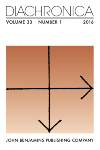
Diachronica
Unraveling the Threads of Linguistic ChangeDiachronica is a prestigious academic journal published by John Benjamins Publishing Co that specializes in the fields of Linguistics and Philosophy. Established in 1984, it has become a significant platform for researchers and scholars to disseminate their work on language change and diachronic linguistics, offering insights into the evolution of languages over time. With an impressive impact factor and recognized rankings within the Q2 category for both Linguistics and Language as well as Philosophy in 2023, Diachronica offers a valuable resource for academics interested in the interplay between historical linguistics and philosophical discourse. Although the journal is not open access, it ensures that its articles are rigorously peer-reviewed and of high academic quality. For researchers, professionals, and students looking to deepen their understanding of language dynamics, Diachronica stands out as an essential component of the scholarly dialogue surrounding linguistic change.
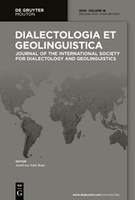
Dialectologia et Geolinguistica
Advancing Knowledge in Dialects and GeolinguisticsDialectologia et Geolinguistica is a prominent academic journal in the field of linguistics, published by De Gruyter Mouton, a respected name in scholarly publishing. With an ISSN of 0942-4040 and an E-ISSN of 1867-0903, this journal is dedicated to the study of dialects and their geographical variants, enriching our understanding of language in its social and cultural contexts. Operating from Germany and serving a global audience, Dialectologia et Geolinguistica has a significant impact factor, placing it in the Q2 category for Linguistics and Language in 2023. The journal's extensive research contributions have earned it notable rankings in both the Arts and Humanities and Social Sciences categories, reflecting its valuable insights into language dynamics. Though currently not an open-access publication, the journal hosts a wealth of research articles spanning various topics within dialectology and geolinguistics, making it an essential resource for researchers, professionals, and students looking to advance their knowledge in these vibrant areas of study.

Revue Roumaine de Linguistique-Romanian Review of Linguistics
Exploring Language in Depth.Revue Roumaine de Linguistique-Romanian Review of Linguistics, published by EDITURA ACAD ROMANE, is a distinguished journal dedicated to advancing the field of linguistics and promoting scholarly discourse in language-related research. With its ISSN 0035-3957, this journal has established itself as a valuable resource for researchers and practitioners alike, particularly within the linguistics and language categories where it holds a respectable Q3 ranking as of 2023. The journal covers a wide array of topics, focusing on both theoretical and applied linguistics, making it an essential platform for those interested in the latest developments, methodologies, and findings in the field. Although it currently does not operate under an open access model, the Romanian Review of Linguistics remains an impactful publication with its regular convergence of years from 2010 to 2023, providing a comprehensive archive for ongoing research endeavors. With its address located in Bucuresti, Romania, this journal continues to foster a vibrant academic community and supports the ongoing exploration of linguistic phenomena across diverse contexts.
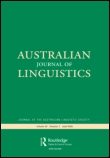
Australian Journal of Linguistics
Advancing the Frontiers of Linguistic ResearchThe Australian Journal of Linguistics, published by Routledge Journals, Taylor & Francis Ltd, stands as a distinguished platform in the field of linguistics, fostering rigorous academic discourse since its inception in 1981. With an ISSN of 0726-8602 and an E-ISSN of 1469-2996, the journal has achieved a notable Q2 ranking in the linguistics and language category for 2023, indicating its quality and relevance within the academic community. With a Scopus ranking of #316 in Arts & Humanities and #373 in Social Sciences, it sits in the 71st and 68th percentiles respectively, underscoring its impact in the fields it encompasses. The journal aims to publish high-quality research articles that contribute to the understanding of linguistic theory, sociolinguistics, and applied linguistics, making it an essential resource for researchers, professionals, and students alike. The journal is based in the United Kingdom, at 2-4 Park Square, Milton Park, Abingdon OX14 4RN, Oxon, England, and actively encourages contributions that can expand the current linguistic discourse, reinforcing its commitment to highlighting diverse perspectives in language research.
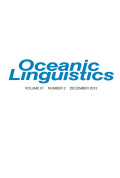
OCEANIC LINGUISTICS
Charting New Waters in Linguistic ScholarshipOCEANIC LINGUISTICS is a premier academic journal published by UNIV HAWAII PRESS, dedicated to the study of languages spoken in the Pacific region. This esteemed journal, bearing ISSN 0029-8115 and E-ISSN 1527-9421, serves as a vital platform for linguists, researchers, and scholars to disseminate significant findings and insights related to Oceania's rich linguistic diversity. With a commendable impact factor and categorized in the Q2 Quartile for the field of linguistics and language, OCEANIC LINGUISTICS ranks 335th out of 1088 in Arts and Humanities and 395th out of 1167 in Social Sciences, reflecting its relevance and influence in ongoing linguistic discourse. The journal is a subscription-based publication, committed to advancing research and fostering scholarly communication from 2004 to 2024, making it an essential resource for anyone engaged in the study of linguistic phenomena in the Oceania region and beyond.
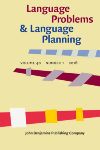
Language Problems & Language Planning
Navigating the Complexities of Language in SocietyLanguage Problems & Language Planning is a pivotal scholarly journal published by John Benjamins Publishing Co, renowned for its contributions to the fields of linguistics, communication, and language studies. With an ISSN of 0272-2690 and an E-ISSN of 1569-9889, this journal has been a cornerstone of academic discourse since its inception in 1977 and will continue to serve as a vital resource until 2024. Currently, it holds a respectable position within the Q3 category in both Communication and Linguistics and Language, reflecting its significant impact in these areas. The journal focuses on the intersection of language-related challenges and planning, addressing critical issues that affect societies worldwide, making it essential reading for researchers, policymakers, and students alike. Although it does not offer Open Access options, its articles provide valuable insights supported by a rigorous peer-review process, fostering a diverse dialogue among scholars and practitioners. Recognized in the Scopus rankings, Language Problems & Language Planning offers a platform for original research and theoretical discussions that advance understanding of language issues in a globalized world.

Catalan Journal of Linguistics
Unlocking Insights into Linguistic Theory and Practice.Catalan Journal of Linguistics is a distinguished academic publication dedicated to the dynamic field of linguistics and language studies. Published by the Universitat Autònoma de Barcelona, this open-access journal has been disseminating impactful research since 2002, making significant contributions to the understanding of linguistic theory, language acquisition, and sociolinguistics, particularly within the Catalan language context. With a robust engagement in the scholarly community, it proudly holds a Q2 ranking in Linguistics and Language as of 2023, reflecting its commitment to high standards of research and innovation. The journal is accessible to a global audience, promoting the free exchange of knowledge beyond geographical boundaries, and serves as an essential platform for researchers, professionals, and students aiming to stay at the forefront of linguistic inquiry. With its rich archive of articles, the Catalan Journal of Linguistics stands as a vital resource for anyone keen to explore contemporary linguistic issues and advancements.

BOLETIN DE LA REAL ACADEMIA ESPANOLA
Connecting Scholars in the World of Language StudiesBOLETIN DE LA REAL ACADEMIA ESPANOLA, published by the Real Academia Española, serves as a central conduit for scholarly discourse in the fields of Linguistics and Language. With an ISSN of 0210-4822 and an E-ISSN of 2445-0898, this esteemed journal has been disseminating impactful research since its inception in 2003. As a recognized Q2 journal in Linguistics and Language for 2023, it ranks in the 45th percentile in Arts and Humanities and 42nd percentile in Social Sciences according to Scopus metrics, reflecting its solid position in academic circles. Although not an open-access journal, it remains a crucial resource for those engaged in the vibrant study of language, providing insights that inform both theoretical frameworks and practical applications. Researchers, professionals, and students alike will find prominent studies and discussions that contribute to the evolution of linguistic scholarship. The journal is published in Madrid, Spain—an environment rich in linguistic heritage that further enhances its significance in the global academic community.

Suvremena Lingvistika
Illuminating the Complexities of Language and Communication.Suvremena Lingvistika is a distinguished open-access journal published by the Croatian Philological Society, dedicated to advancing research in the field of linguistics and language. Since its establishment, the journal has been pivotal in promoting scholarly dialogue within the linguistics community, especially among researchers and academics in Croatia and beyond. With an ISSN of 0586-0296 and an E-ISSN of 1847-117X, the journal has transitioned to an open-access model since 2007, ensuring that research is freely accessible to all. As of 2023, it holds a respectable Q3 ranking in the Linguistics and Language category, reflecting its potential contribution to the field. The journal's scope encompasses a wide array of linguistic disciplines, encouraging both theoretical and empirical studies. Supportive of new research, Suvremena Lingvistika aims to foster innovative approaches and methodologies in linguistics, making it an essential resource for students, researchers, and professionals eager to explore the complexities of language. With its ongoing publication until 2024, it continues to shape the linguistic landscape, providing valuable insights and fostering collaboration among scholars globally.